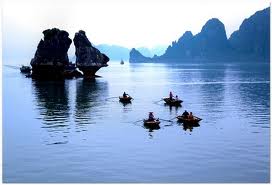Charter Cruises
Premium Cruises
Superior Cruises
Ha Long Bay is selected Top 10 Valentine’s Day Retreats by National Geographic's travel site

Ha Long Bay - the most famous tourist attraction in northern Vietnam - is selected one of the top 10 Valentine's Day Retreats by the National Geographic's travel site.
The Top 10 Valentine’s Day Retreats also include Post Ranch Inn in California, USA; Sedona in Arizona, USA; Covered Bridges in Vermont, USA; British Pullman Train, the United Kingdom; Hotel Kakslauttanen, Finland; Eiffel Tower, France; Via Dell’Amore, Cinque Terre, Italy; Istrian, Croatia; and Classical Gardens of Suzhou, China.
Ha Long Bay, located in the Gulf of Tonkin, within Quang Ninh Province, in the northeast of Vietnam, is 165 km from the capital of Hanoi. Covering an area of 43,400 ha and including over 1,600 islands and islets, most of which are uninhabited and unaffected by humans, it forms a spectacular seascape of limestone pillars and is an ideal model of a mature Karst landscape developed during a warm and wet tropical climate. The property’s exceptional scenic beauty is complemented by its great biological interest.
The outstanding value of the property is centered around the drowned limestone karst landforms, displaying spectacular pillars with a variety of coastal erosional features such as arches and caves which form a majestic natural scenery.
The repeated regression and transgression of the sea on the limestone karst over geological time has produced a mature landscape of clusters of conical peaks and isolated towers which were modified by sea invasion, adding an extra element to the process of lateral undercutting of the limestone towers and islands.
T. Van
Latest News
- Ha Long Bay and Son Doong Cave were named among the most beautiful places by GlobalGrasshopper
- Promoting Sustainable Tourism in Halong Bay
- Developing craft village tourism in Viet Nam
- Ha Long Bay is selected Top 10 Valentine’s Day Retreats by National Geographic's travel site
- Vietnam tourism is looking forward to receiving 8 million foreign visitors in 2014














